
Minute Man Park brings history to life
CONCORD, Mass.— With eyes wide open and holding tight to their mother’s hand the two young boys listen intently to the man dressed in a British Regular uniform.
The volunteer lets the children touch his knapsack and his clothing while he tells the story of Paul Revere’s famous ride, the fight between British Regulars and the Minute Men militia, colonists’ rights, and “the shot that was heard around the world.”
Offering a wide range of educational programs, living history characters and role-playing, the staff and volunteers at Minute Man National Historical Park bring history alive to scores of visitors, young and old alike.
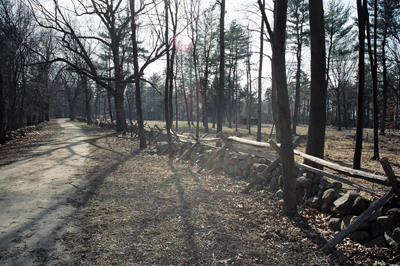 |
The Battle Road Trail between Concord and Lexington is a soft dirt road that is easy for walking and connects many of the historic sites in the area (Photo by Sofia Forteza). |
Located approximately 15 miles northwest of Boston, the serene and beautiful Minute Man National Historical Park is nestled between the towns of Concord and Lexington.
Created by an act of Congress in 1959 to preserve, selectively restore and interpret portions of the Lexington-Concord Battle Road, Minute Man National Park has 967 acres divided into three distinct sections: the North Bridge, the Wayside and the Battle Road unit, which encompasses the five-mile Battle Road Trail that connects many of the historic sites.
Since its inception, the park has restored the colonial landscape, torn down all modern buildings, repaired existing stone walls to their original state, cleared fields to make the area resemble the colonial period and maintained the remaining 50 colonial structures within its boundaries.
| Minute Man Natiional Park Rangers Jim Hollister, left, and Lou Sideris (Photo by Sofia Forteza). | 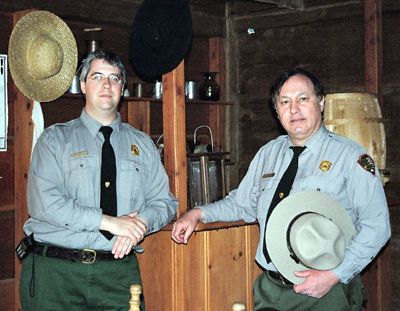 |
“April is the most important month for the park,” said Park Ranger Jim Hollister. “ Patriots’ Day is more important around here than the Fourth of July. More than 200 volunteers dress up in period costumes and reenact the events of 1775.”
Volunteers donate, on average, more than 15,000 hours to the park. In addition to re-enactments and living history activities, volunteers assist park rangers at the visitors’ center, clear trails, conduct historic research and update the park’s library center.
Due to budgetary constraints, only two park rangers are now employed full-time throughout the year. Volunteers and seasonal workers help out during the busy season from June through October.
“The park averages one million visitors a year,” said Park Ranger Lou Sideris. “April, May and June is when schools visit the most. We now charge a fee of $150 for groups and it includes a two-hour guided tour with Jim dressed-up in period costume. We used to do it for free, but had to change our policy.”
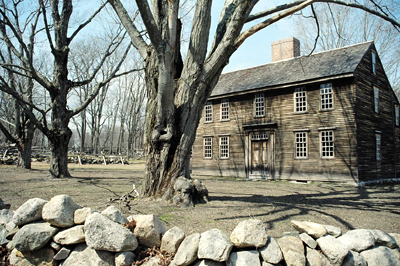 |
The exterior of Hartwell Tavern (Photo by Sofia Forteza) |
Visitors typically begin by going first to the Minute Man Visitors Center and seeing the 30-minute award-winning multimedia theater show. This captivating show is very helpful to put into context and place the events and actions that occurred at the time.
The Battle Road Trail pathway connects the park’s sites crossing farmlands, fields, and forests. The five-mile long park can be toured by foot, bicycle or by car.
| One of the rooms of Hartwell Tavern features period furnishings (Photo by Sofia Forteza) |
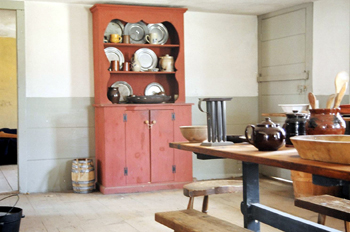 |
The restored dirt and clay road winds past the doorstep of the historical Hartwell Tavern, home to successful farmer and innkeeper Ephraim Hartwell, his wife Elizabeth, and their children. Used as a meeting place, travelers and locals alike stopped to share the news of the day.
Five designated parking areas are visibly marked along Route 2A allowing drivers to stop and explore the surrounding areas.
Points of historical interest are the spot were Paul Revere was captured and Meriam’s Corner, the field where British regulars first came under fire as they retreated to Boston marking the start of the six-hour fight known as Battle Road.
Only one-third of a mile from Meriam’s Corner, is The Wayside, home of Samuel Whitney, muster master of the Concord Minute Men— the small hand-picked force selected from the local militia chosen to be ready to march or fight at a minute’s notice.
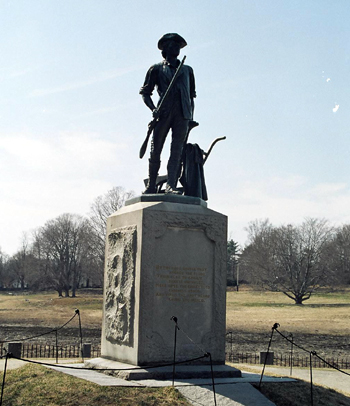 |
The statue honoring the Minute Men occupies a prominent place in the park (Photo by Sofia Forteza). |
During the 19th century the house was also home to writers Louisa May Alcott, Nathaniel Hawthorne and Harriet Lothrop, better known by her pen name of Margaret Sidney.
A good way to end the tour is to stop at the Concord’s North Bridge Visitors Center, a home built by the descendants of Major John Buttrick, the colonial officer who gave the command to fire “the shot heard around the world.”
A must see is the “Hancock Cannon,” one of four brass cannons stolen from the British and used during the revolutionary war.
| The site of the “shot heard ’round the world” at Minute Man National Park (Photo by Sofia Forteza). |
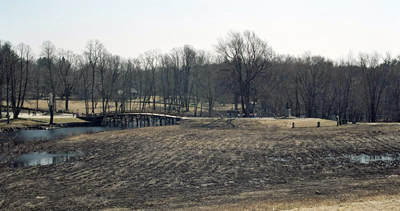 |
Only a couple minutes walk down from the visitor center is the Lexington Battle Green, the first battleground site where, on the morning of April 19, 1775, the Minute Men led the attack on Concord’s North Bridge, their numbers reinforced by the Lexington militia later in the day.
Daniel Chester French’s famous Minute Man Statue sculpted to honor the citizen-soldier of 1775 stands next to the North Bridge, site of the event that sparked the beginning of the long road to independence.
“The park is visited by people from around the world,” Hollister said. “They come because they want to see the place where the ideals of freedom and independence began.”
 |
| Map courtesy of National Park Service. |

Comments are Closed